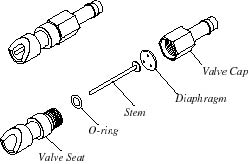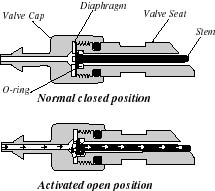We use cookies to make your experience better. To comply with the new e-Privacy directive, we need to ask for your consent to set the cookies Learn more.
To drink, the animal or bird simply moves the stainless steel stem by biting, licking, or pecking. This action causes water to flow out of the valve. When the animal releases the end of the stem, the elasticity of the silicone rubber diaphragm located behind the stem head pushes it back to the closed position, stopping the flow of water. Animals and birds quickly train themselves how to drink from the Edstrom valve.
Watering Guinea Pigs and Mice
Special considerations need to be given to setting up automated watering systems for commercial guinea pig and mouse facilities. Both animals species are prone to playing with the Drinking Valve and causing spillage into the cage. Not only is this spillage messy, but it can cause health problems for the animals. If animals are left in cages with wet bedding they can quickly suffer from hypothermia and die.
Edstrom offers a special Drinking Valve with a play-guard which is recommended for use with guinea pigs and mice. This GP/Mouse Drinking Valve, 1000-1451-GP, incorporates the same reliable operating mechanism as the Vari-Flo Drinking Valve. It has the same low actuation force, making it usable by weanling mice. It is made of stainless steel to withstand the gnawing of the animals.
The special GP/Mouse Drinking Valve with play-guard helps reduce the amount of spillage by playful guinea pigs and mice in two ways:
In Guinea Pig cages it is recommended that the Drinking Valve be mounted in an area of the cage having wire flooring, to eliminate the possibility of damp cage floors.
Mice are often housed in solid plastic cages with bedding, which makes the installation of the GP/Mouse Drinking Valve very critical. The mice will often stick the bedding material into the Drinking Valve, which can lodge it in the open position, allowing water to flow into the cage. Such a continuous leak will quickly wet all the bedding in the cage and lead to the death of the animals.
It has been found that certain bedding materials can be more prone to causing leaking problems; use of fine wood chip bedding material should be avoided. It is the operator's responsibility to carefully monitor the animals activities to confirm that they are not developing the habit of sticking bedding into the Drinking Valve producing a leak.
Many breeders using solid plastic cages have good luck mounting the GP/Mouse Drinking Valve on the top of the cage, clipped to a wire mesh cover. Of course the cage design must permit a method for the mice to crawl up to the top and reach the Drinking Valve.
The GP/Mouse Drinking Valve can also be mounted through the side-wall of the cage by punching a 5/8 inch hole in the end of the cage and pressing on the protective brass grommet (available from Edstrom.) The Drinking Valve is inserted through the grommet to protrude into the cage.
Important: No matter what installation method you use, it is critical that you closely monitor the operation of the Drinking Valves to avoid any problems with the mice sticking bedding in the valves and causing leaks.


In the normal, closed position, the head of the stem is held securely against the O-ring by the elastic diaphragm, preventing water from flowing under the stem head and out the valve.
When the end of the stem is moved in any direction by biting, licking or pecking, the head of the stem pivots on the O-ring. One side of the head lifts off the O-ring and allows water to flow under it and out to the animal's mouth or beak.
When the animal releases the end of the stem, the elasticity of the silicone rubber diaphragm located behind the stem head pushes the head back to the closed position, stopping the flow of water.
The many advantages and benefits of this simple valve design.
Local plumbing codes may require that you install an Auto-Air Break Valve at the point you connect your automated watering system to your domestic water supply. Use an approved device for this purpose.